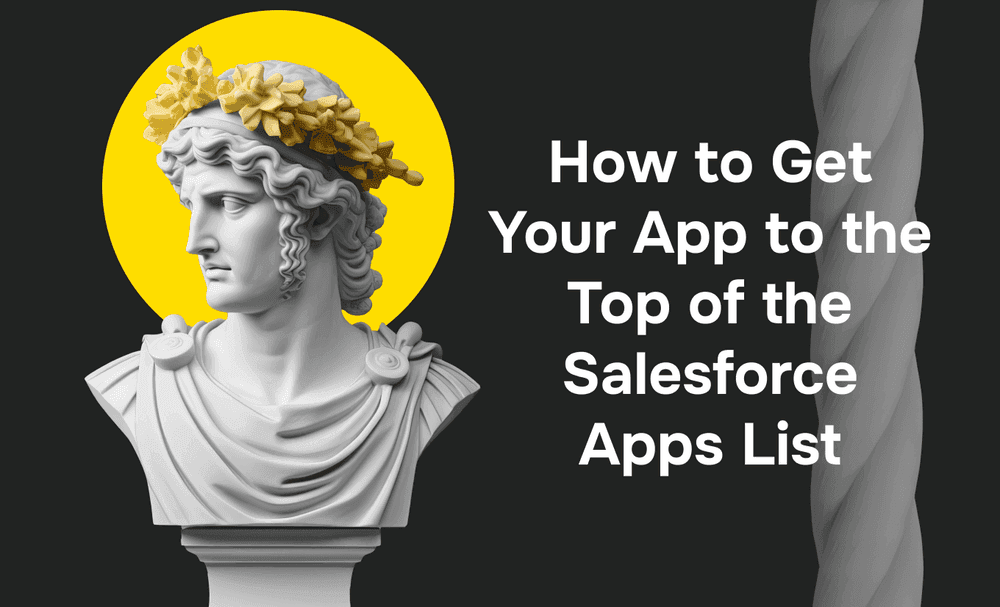On Salesforce AppExchange, visibility can make or break your app’s success. Web and mobile apps that rank higher in search results not only attract significantly more traffic but also experience a substantial increase in installs. In fact, studies suggest that top-ranked apps can get as much as 80% more visibility than those that appear further down the list, directly leading to higher engagement and conversions. For Salesforce ISVs, improving your app’s AppExchange ranking is crucial to standing out in an increasingly crowded marketplace.
But what steps can you take to rise to the top?
We’ll cover how to enhance your app’s listing with engaging content and marketing, establish credibility through user reviews, and build a community presence - all of which will boost your app’s visibility and drive installs. Ready to see your application in the top Salesforce apps list? Let’s dive into the steps to help you boost productivity and get your app to the top.
Keyword Optimization for AppExchange Listings
Keyword optimization is foundational to improving your app’s visibility on Salesforce AppExchange. By carefully selecting and strategically integrating relevant search terms, you can significantly boost your app’s chances of being discovered by potential users. It’s essential to understand how users search for apps on AppExchange and how to align your app’s listing with those search behaviors.
Conducting Keyword Research to Identify Relevant Search Terms
This research process involves understanding the language and keywords commonly used by your target audience - whether they are Salesforce administrators, business analysts, or IT professionals.
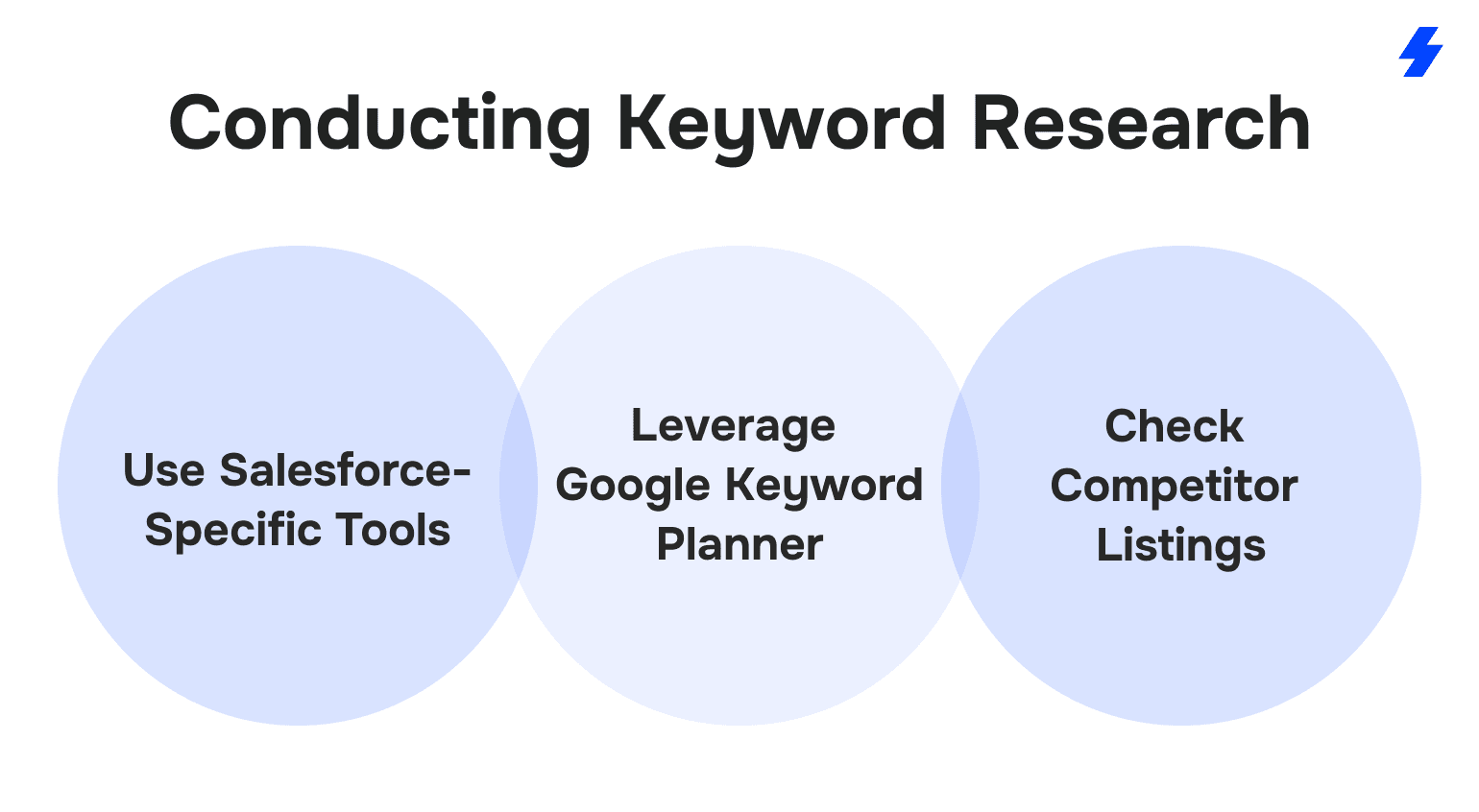
Use Salesforce-Specific Tools
Salesforce offers tools like the AppExchange search function and Salesforce Schema Builder. Salesforce Schema Builder is a tool that is strictly used to visualize and manage your data model within Salesforce. It lets you see and configure objects, fields, and relationships in a drag-and-drop interface, which is super helpful for understanding how your data is structured. Use these to analyze what terms appear frequently in competitor listings and compare the results of similar apps or competitors in your category.
Leverage Google Keyword Planner
Google Keyword Planner can be a helpful tool for identifying related keywords that are being searched on other digital platforms, even outside of Salesforce. Use it to discover high-traffic keywords that align with your app's functionality.
Many first-time ISV publishers assume Google-style SEO works 1:1 on AppExchange. That’s not true. Salesforce uses search keyword fields and metadata, and heavily weights ratings, installs, and engagement.
Check Competitor Listings
Browse through similar apps on AppExchange and pay close attention to their titles, descriptions, and keyword choices. Tools like Ahrefs or SEMrush can also provide detailed insight into the keywords competitors rank for their services, helping you target gaps in their keyword strategy.
Strategically Integrating Keywords in Titles, Descriptions, and "Search Keywords" Fields
Once you've identified your relevant keywords, the next step is integrating them into your AppExchange listing. Keyword optimization isn't just about stuffing terms into your title or description; it’s about incorporating them in a way that reads naturally and enhances your app’s appeal.
Titles
Your app’s title is one of the most important places to use your keywords. The title should communicate what your app does and include the most relevant search term. A concise, keyword-rich title suits SEO and helps potential users immediately understand what your app offers.
Descriptions
Your app description should provide a detailed overview of the features and benefits while naturally incorporating your target keywords. Consider how users will phrase their needs when searching for an app that solves their problems. Use relevant keywords in the first 100-150 characters, as this is what potential users see first.
"Search Keywords" Fields
Salesforce AppExchange allows you to include "Search Keywords" in the AppExchange Publisher Console, which help categorize and rank your app within the platform. Keep in mind that you have a 256-character limit for these keywords. It's essential to use a combination of specific and broad terms that reflect your app’s core functionalities to drive optimal search traffic.
Avoid Keyword Stuffing
While it’s essential to use keywords strategically, avoid overstuffing your listing with excessive keywords. Like Google’s, Salesforce’s algorithms can penalize listings that appear unnatural or spammy. Focus on a few well-researched, high-impact keywords and integrate them into your content.
Practical Tips for Keyword Optimization
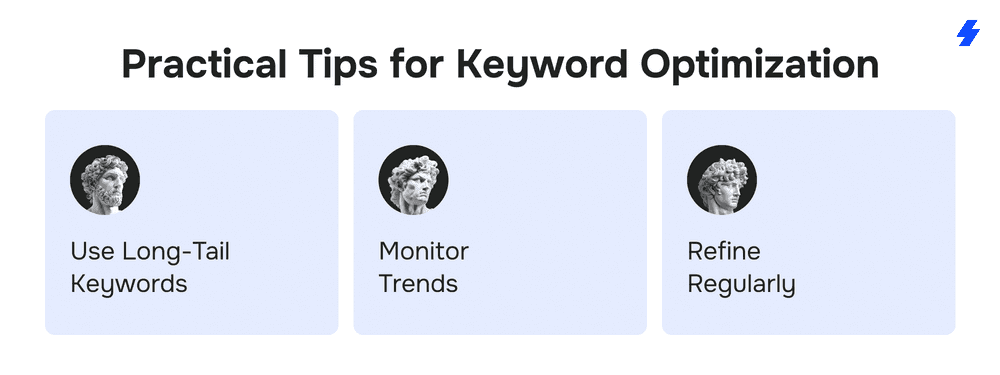
- Use Long-Tail Keywords: Besides broad keywords, incorporate long-tail keywords (e.g., "Salesforce sales automation for small businesses") to target more specific user needs. These tend to have lower competition and can attract more qualified leads.
- Monitor Trends: As Salesforce evolves, keywords can change over time. To stay on top of trending search terms within the Salesforce ecosystem, subscribe to forums and Salesforce blogs or use tools like Google Trends.
- Refine Regularly: Keyword optimization isn’t a one-time task. Monitor your app’s performance on AppExchange and adjust your keywords based on new trends, user feedback, or market shifts.
Engaging Visual Content
Visual content is crucial for making your Salesforce AppExchange listing stand out. High-quality screenshots and demo videos help users clearly understand your app’s functionality and features, leading to better engagement and higher installs.
High-Quality Screenshots
Screenshots give potential users a first look at your app. Ensure your images are clear, focused, and showcase your app's key features. Highlight unique functionalities with annotations, such as "Customizable Dashboards" or "Real-time Analytics." Avoid clutter and make each screenshot visually appealing to help users quickly grasp the app’s value.
Ensure screenshots follow AppExchange image guidelines: JPEG/PNG format, 1280x720 resolution, and max 10 screenshots per listing.

Adding brief annotations or arrows to your screenshots can guide users' attention to important features. For instance, if your app integrates customer preferences and Salesforce data from multiple sources, highlight this functionality with a note like “Seamlessly integrates customer data from X, Y, Z systems.”
Demo Videos
A concise, 1-2 minute demo video can effectively showcase how your app works in action. Focus on key features, show real use cases, and keep the video clear and engaging. Narration and text overlays can enhance understanding, and optimizing the video for mobile ensures it’s accessible on all devices.
If your app automates email marketing within Salesforce platform, create a demo video that walks the viewer through the setup process, the templates available, and how to send personalized emails. As you describe and demonstrate these features, include text captions like "Set up in minutes" or "Automatically segment your contacts" to make it clear how users benefit.
Building Community Connections
Building strong community connections within the Salesforce ecosystem is a powerful way to boost your app’s visibility and credibility. Active participation in Salesforce user groups, forums, and events helps establish your app as a trusted solution, while engaging directly with potential users and sales teams builds meaningful relationships.
Active Participation in Salesforce User Groups, Forums, and Community Events
Salesforce’s vibrant community provides numerous opportunities for developers to interact with potential customers. By actively engaging in Salesforce user groups and forums, you not only stay up-to-date on industry trends but also build a network of loyal users and business together.
Participate in local and online user groups focused on Salesforce topics related to your app. This is a great way to connect with people who are already using Salesforce and might be interested in your app.
Contribute to discussions on forums like the Salesforce Developer Community or the Salesforce Stack Exchange. Answering questions and providing helpful insights and solutions can build your reputation as an expert in your field.
Leveraging Webinars and Q&A Sessions
Webinars and Q&A sessions provide your company with a platform to interact with potential users in real-time, showcasing your app’s features and addressing user concerns directly. Hosting educational webinars can help you demonstrate your app’s value and answer common questions, while building trust through transparent communication.
Organize webinars to demonstrate your app’s features in action. This allows you to show potential users how your app can solve their specific problems. Be sure to provide a clear agenda and keep the session interactive.
Host live Q&A sessions where users can ask questions about your app, implementation, and best practices. These sessions foster trust and help clarify any doubts.
Encouraging User Reviews and Ratings
User reviews and ratings are crucial for building credibility and improving your app's ranking on AppExchange. Positive reviews increase trust, while constructive feedback helps you improve your app.
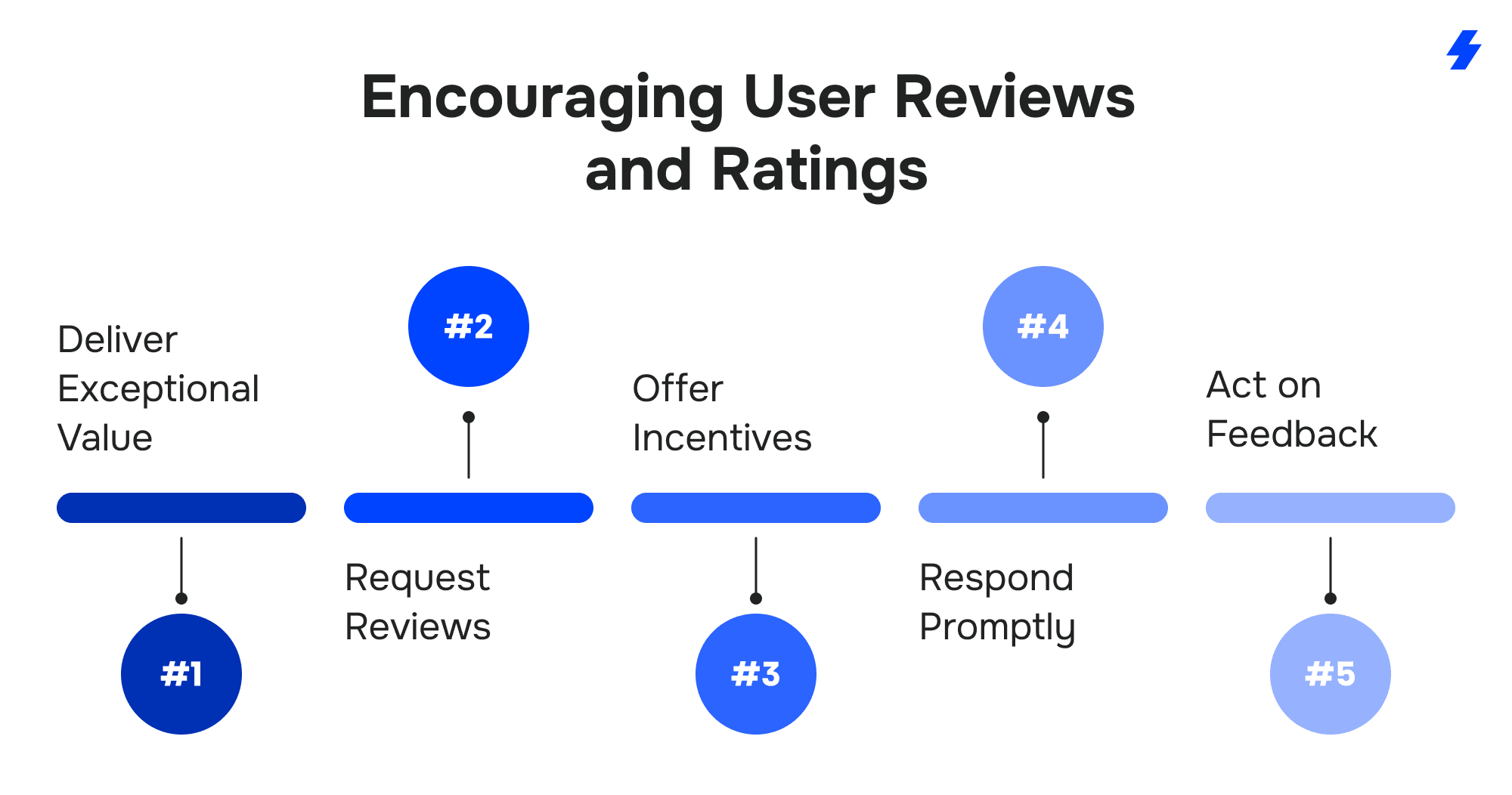
- Deliver Exceptional Value: Ensure your app meets user needs and offers clear benefits. Satisfied users are more likely to leave positive reviews.
- Request Reviews: Politely ask satisfied users to leave a review. Include a simple call to action after successful interactions or support resolutions.
- Offer Incentives: Consider offering incentives, such as extended trials or exclusive features, in exchange for feedback.
- Respond Promptly: Acknowledge both positive and negative feedback quickly. Show appreciation for positive reviews and address concerns professionally.
- Act on Feedback: Regularly update your app based on user suggestions, demonstrating your commitment to continuous improvement.
Content Marketing for Visibility
Content marketing is a powerful strategy for driving visibility and establishing thought leadership in your category within the Salesforce ecosystem. By creating valuable, engaging content around your app’s value, you can not only attract potential users but also increase your app’s credibility and organic reach.
Write informative blog posts, case studies, and articles that focus on your app’s core value proposition. Address common challenges that your target audience faces, and show how your app can solve these issues.
For example, if your app helps automate data entry within Salesforce, write a post about how automation can improve efficiency and reduce errors in CRM data management.
Video content, especially product demos or explainer videos, is an excellent way to show your app in action. Videos help users visualize how your app solves their problems, making it more compelling than static images or text alone. Demonstrate the app’s key features and explain how it integrates with Salesforce to streamline processes.
Sharing your blog posts, articles, and videos on social media platforms such as LinkedIn, Twitter, and Facebook helps increase organic reach. Social media enables you to connect directly with your audience and share valuable insights. Engage with your followers through comments, shares, and discussions, turning your content into a conversation that builds trust and interest in your app.
Adding Value Through Free Trials and Demos
Offering a free trial or live demo is one of the most effective ways to reduce onboarding friction and accelerate adoption. It gives prospective users hands-on experience with your app, allowing them the ability to assess its value before committing. This transparency can make your app stand out in the Salesforce AppExchange ecosystem - where competition is high and trust matters.
A free trial allows users to explore your app’s features at their own pace. Whether it's a 7-day or 30-day trial, this approach builds user confidence and shortens the sales cycle.
- Make onboarding easy: Include in-app guidance, tooltips, or a quick-start checklist. Tools like WalkMe or Whatfix can enhance the trial experience.
- Limit risk, not features: Instead of limiting functionality, consider limiting usage time. This lets users truly understand your app’s capabilities.
Live demo sessions are a great tool that offers a structured opportunity to showcase your app’s strengths and answer questions in real time. They work especially well for complex apps that benefit from guided explanations.
- Host regular group demos: Offer weekly 20–30-minute walkthroughs with time for Q&A. Platforms like Zoom or Demio work well for this format.
- Tailor demos to roles: Create different demos for Salesforce admins, sales teams, or IT managers, depending on their needs.
- Offer recorded sessions: Provide an on-demand demo video on your AppExchange listing or website so users can view it at their convenience.
Using Analytics to Optimize Your App
Analytics are a game changer for understanding how users engage with your app listing, and where there’s room to improve. By tracking metrics like page views, trial activations, and user behavior, you can refine your AppExchange strategy for better visibility and conversion rates.
Start by regularly tracking the performance of your listing and user engagement metrics:
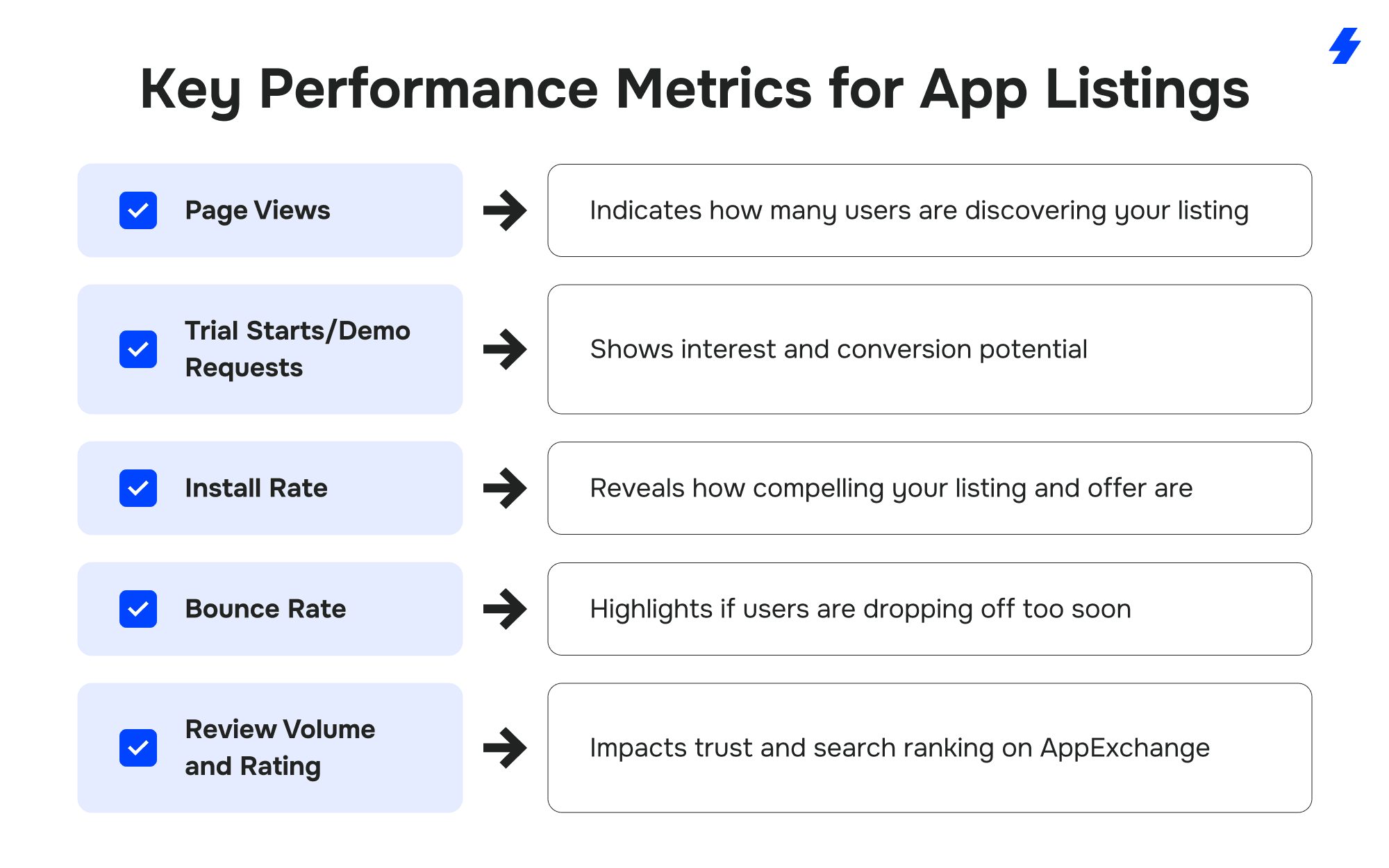
Salesforce doesn’t currently offer deep in-platform analytics for AppExchange listings, but you can use tools like UTM parameters and Google Analytics to track traffic from external content, campaigns, and referral links.
Conclusion
Getting to the top of the Salesforce AppExchange listings isn’t a one-time effort; it’s an ongoing process that requires strategic focus, community engagement, and continuous optimization. From keyword-rich listings and compelling visuals to user-driven reviews and community involvement, every element plays a role in how your app is discovered and trusted.
To maintain a strong presence, regularly update your listing with fresh content, respond to user feedback, and stay involved in Salesforce communities. Apps that evolve with user needs and platform trends not only rise in rankings but also build lasting customer loyalty.
Need help getting there? At MagicFuse, we specialize in helping Salesforce ISVs build, launch, and grow high-performing best Salesforce apps. Whether you need support with development, security review, or optimizing your listing - we’ve got you covered. Contact us to take your AppExchange strategy to the next level.
FAQs
How can I optimize my AppExchange listing for better visibility?
Use relevant keywords in your title, description, and search fields. Include high-quality visuals, and a compelling value proposition, and encourage positive reviews. Regularly update the content based on performance metrics and user feedback.
What are effective ways to increase user reviews on AppExchange?
Ask for reviews after customer success with interactions, offer incentives like extended trials, and make it easy for users to leave feedback. Always respond to positive and negative reviews to show you value user input.
How does MagicFuse help with AppExchange app development?
MagicFuse offers end-to-end Salesforce app development services, including product design, development, integration, security review preparation, and listing optimization to ensure your app performs well on AppExchange.
What steps can MagicFuse take to ensure my app passes the Salesforce security review?
We conduct thorough code reviews, enforce secure coding practices, and run internal security audits. Our team ensures your app complies with Salesforce’s Security Review guidelines, increasing the chances of a smooth approval.
